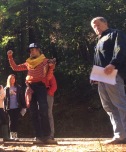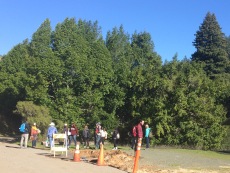By Niall Ogburn, Danielle Wegner, and Michael Lutz. (All photos: Lutz)

The welcoming committee, comprised of Sarah Phillips (right), Eric Ettinger (middle), and Erik Young (left).

Eric Ettlinger standing in front of Lagunitas Creek
Cruising through the meandering roads of west Marin County, the students of Restoration Ecology at Sonoma State were about to experience salmon restoration efforts performed in the real world. Pulling into the parking lot of the Leo T. Cronin Fish Viewing Area, we were greeted by an eclectic salmon welcoming committee. The group comprised of SSU alumna Sarah Phillips of the Marin Resource Conservation Department (RCD), Erik Young of Trout Unlimited, and Eric Ettlinger of Marin Water District. Each of these individuals provides a distinct viewpoint fromtheir different areas of expertise towards one common purpose: restoring the Coho salmon (Oncorhynchus kisutch) population of west Marin. This provides a perfect example of a critical concept learned in the classroom: understanding how to build bridges across various agencies and stakeholder viewpoints to get everyone on board with a restoration project.

Large woody debris visible from the Leo T. Cronin fish viewing area
In the shaded parking lot of Leo T. Cronin Fish Viewing Area, our first of three stops, we received background information on the history of salmon restoration in Marin county along with a perspective of different agency roles within the restoration process. Sarah kicked things off by providing background information on the anadromous lifestyle and the ocean-to-freshwater stream journey these fish traverse in order to spawn. We also went over the importance habitat health of streams and riparian habits have in order to protect the salmon eggs, and salmon babies, officially known as fry, as they grow into adults and make their way back to the ocean.
Sarah also explained the unique role she plays as Urban Stream Coordinator, finding ways to connect the local community to the restoration project, opening up resources along with developing ways to promote sustainable living to protect salmon streams from degradation.
After explaining her role at the RCD, Eric Ettlinger of Marin Water District stepped in and explained the importance of woody debris and his task in monitoring abundance of Coho salmon along with creating woody debris restoration sites. We learned that past efforts to clear streams of woody debris are exactly the opposite of what is needed for the stream! Eric explained how he has to develop projects that will reinstate loss woody debris piles that are needed in the upper stream and creating slow moving wider rivers downstream.
Next, we heard from Erik Young, a retired lawyer and professor who now works with Trout Unlimited. Erik shared with us some stories about the entanglement of litigation that comes with creating and implementing a restoration project that involves an endangered species under the Endangered Species Act.
With all of this information on the complexities of salmon conservation efforts, it was time to move on to the second stop. Hopes were running high for the opportunity to see this infamous fish.
At Lagunitas Creek, Eric Ettlinger explained the process female salmon use to create their nests. He was mid sentence when we heard a large splash in the water behind him. What could it be?! It was a female salmon creating the very thing that Eric was just talking about! A Chinook salmon was in the process of creating what is known as a redd: the female digs out a small pocket in the stream bed by flopping around and using her tail to create a safe spot where she can lay her eggs.
After the excitement of seeing this endangered salmon, we headed back up to the vans and drove to our third and final spot, Devil’s Gulch.
Upon reaching our final stop, we decided it would be a good time to stop and have lunch, so the whole class sat down on the ground and enjoyed the warm of the sunshine on a brisk day while listening to Sarah talk about her days at Sonoma State where she once took some of the classes that we are in now!
After we all finished lunch, we headed out of the sun and into the shade of the creek canopy, as we went down to Devil’s Gulch to view several woody debris restoration projects that had been completed by Sarah and the rest of the team. Along the way, we tried to avoid the poison oak that was abundant along the path. We learned how the woody debris was brought down to the creek using machinery that would cause minimal damage to the surrounding areas of the creek. At our last spot on the creek, set beside patches of stinging nettle that give Devil’s Gulch its name, Sarah shared with us some of the struggles involved with getting permits and working with local government and community members in order to make these types of projects happen. She explained to us that it was a difficult area of her job that took a lot of effort, and stressed a need for the will to never stop trying to achieve your goal, even if your project proposals are rejected the first couple of times.

One example of the large woody debris installed at the Devil’s Gulch Restoration site with a large subsequent pool visible
It was extremely interesting to learn about the projects that were done in the Lagunitas Creek and how many benefits the woody debris has for the restoration of the salmon. It was also an absolute pleasure to have three very different backgrounds in the form of Eric, Sarah, and Erik to bring together the vast amount of knowledge they had on the subject and inform us of the importance of their work that they have been doing. They really showed us that even though you may come from different fields of work and focus on different aspects of a project, it is extremely valuable to have different minds come together to unite and complete a common goal for the betterment of the environment and the species that live in it.




Pingback: Salmonid Field Trip – Teacup Rex